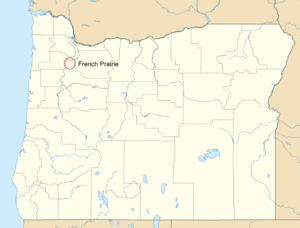French Prairie
French Prairie is a prairie located in Marion County, Oregon, United States, in the Willamette Valley between the Willamette River and the Pudding River, north of Salem. It was named for some of the earliest settlers of that part of the Oregon Country, French Canadian/Métis[1] people who were mostly former employees of the Hudson's Bay Company.[2] French Prairie is also known as an early Métis settlement in the Pacific Northwest history.[3]

History
European American settlement
The European presence in the French Prairie area began with Wallace House in 1812, near the present city of Keizer, Oregon. The station was a fur trading post built by William Wallace Matthews and John C. Halsley of the Pacific Fur Company.[4] The Willamette Trading Post was established in 1814 by the North West Company near the site of Champoeg.[1]
In the 1830s the French Canadian settlers, who were Roman Catholic, petitioned to Norbert Provencher, the Bishop of Juliopolis at the Red River Colony (present-day Winnipeg, Manitoba, Canada) to have a priest sent to them.[5][6] Two of these petitions were sent in 1836 and 1837. Bishop François Norbert Blanchet finally arrived in the French Prairie area in 1838. These first French Canadian settlers built hewn log homes in the French style and started wheat farms.[7] The homes were built with clay and stick chimneys, ash bark roofs, and animal skin windows that were similar to the homes built on the eastern Canadian frontier.[7] By 1843, approximately 100 French Canadian/Métis families lived on the prairie.[7]
The St. Paul Roman Catholic Church, in St. Paul, was built in 1846 by the settlers of French Prairie and is the oldest brick building still standing in the Pacific Northwest.[1]
Later settlement
For a short time in the 1880s the Oregonian Railway Company had a station named French Prairie about two miles southeast of the city of St. Paul.[2]
French Prairie today
The French Prairie area is still an important agricultural area of the Willamette Valley, and there is concern about urban development encroaching on arable land.[8]
Geography
Generally, the French Prairie is bounded by the Pudding River on the east, the Salem-Keizer metropolitan area on the south, and the Willamette River on both the north and west as the Willamette makes a 90 degree turn to the south near Newberg.[7] Settlements on French Prairie founded by French Canadians include Butteville, Champoeg, Gervais, Saint Louis, and St. Paul.
Notable residents
- Pierre Belleque
- Marie Aioe Dorion
- Joseph Gervais
- Michel Laframboise
- Étienne Lucier
- François X. Matthieu
References
- Edmonston, George P., Jr.; Patricia Filip. "Rewrites". A look at five OSU researchers who are revolutionizing their academic disciplines. Oregon Stater. Archived from the original on 2007-02-22. Retrieved 2007-03-17.
- McArthur, Lewis A.; Lewis L. McArthur (2003) [1928]. Oregon Geographic Names (7th ed.). Portland, Oregon: Oregon Historical Society Press. ISBN 0-87595-277-1.
- Barman, Jean French Canadians, furs, and indigenous women in the making of the Pacific Northwest. UBC Press. Vancouver 2014. Chapter 7: "Initiating Permanent Settlement"
- Henry, Alexander, and David Thompson. New Light on the Early History of the Greater Northwest: The Manuscript Journals of Alexander Henry, Fur Trader of the Northwest Company, and of David Thompson, Official Geographer and Explorer of the Same Company, 1799-1814 ; Exploration and Adventure among the Indians on the Red, Saskatchewan, Missouri, and Columbia Rivers. Edited by Elliott Coues. Vol. 2. New York City: Francis P. Harper, 1897. pp. 817-818.
- Lenzen, Connie. "Settlers on French Prairie, Oregon Territory in 1836-1838". Archived from the original on 2007-09-29. Retrieved 2007-03-17.
- "Willamette Settlers to the Bishop of Juliopolis". Oregon Historical Society. Retrieved July 23, 2012.
- Chapman, J. S. (1993). French prairie ceramics: the Harriet D. Munnick archaeological collection, circa 1820-1860: a catalog and Northwest comparative guide. Anthropology northwest, no. 8. Corvallis, Or: Dept. of Anthropology, Oregon State University.
- "Minutes of the Board Session". Marion County Board of Commissioners. 2006-03-08. Archived from the original on September 28, 2007. Retrieved 2007-03-17.
External links
- List of Settlers West of Rockies, 1842 by Elijah White, Indian Agent
- French Canadians in the 1842 Oregon census (has detailed biographies of some of the settlers)
- Historic photos from the French Prairie area from Salem Public Library
- Friends of French Prairie land-use planning organization
- Jetté, Melinda. "French Prairie". The Oregon Encyclopedia.